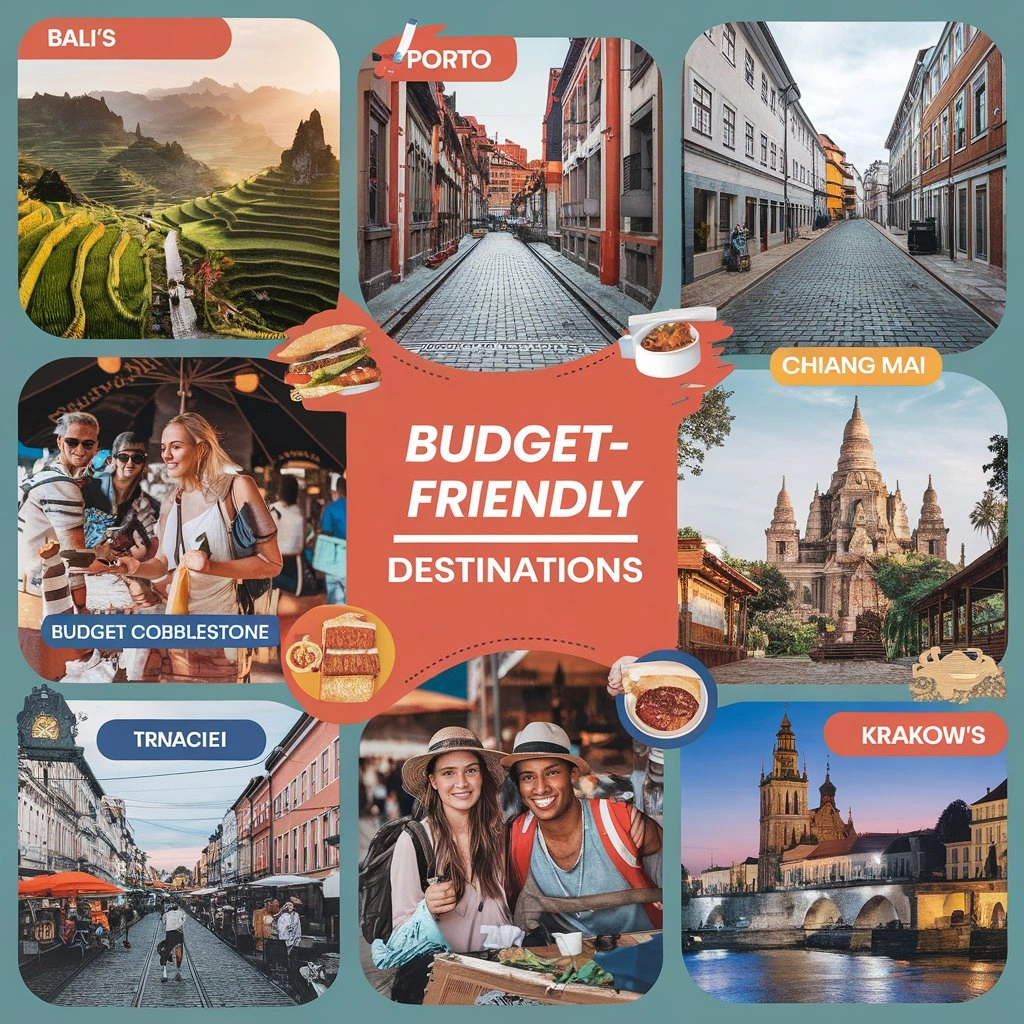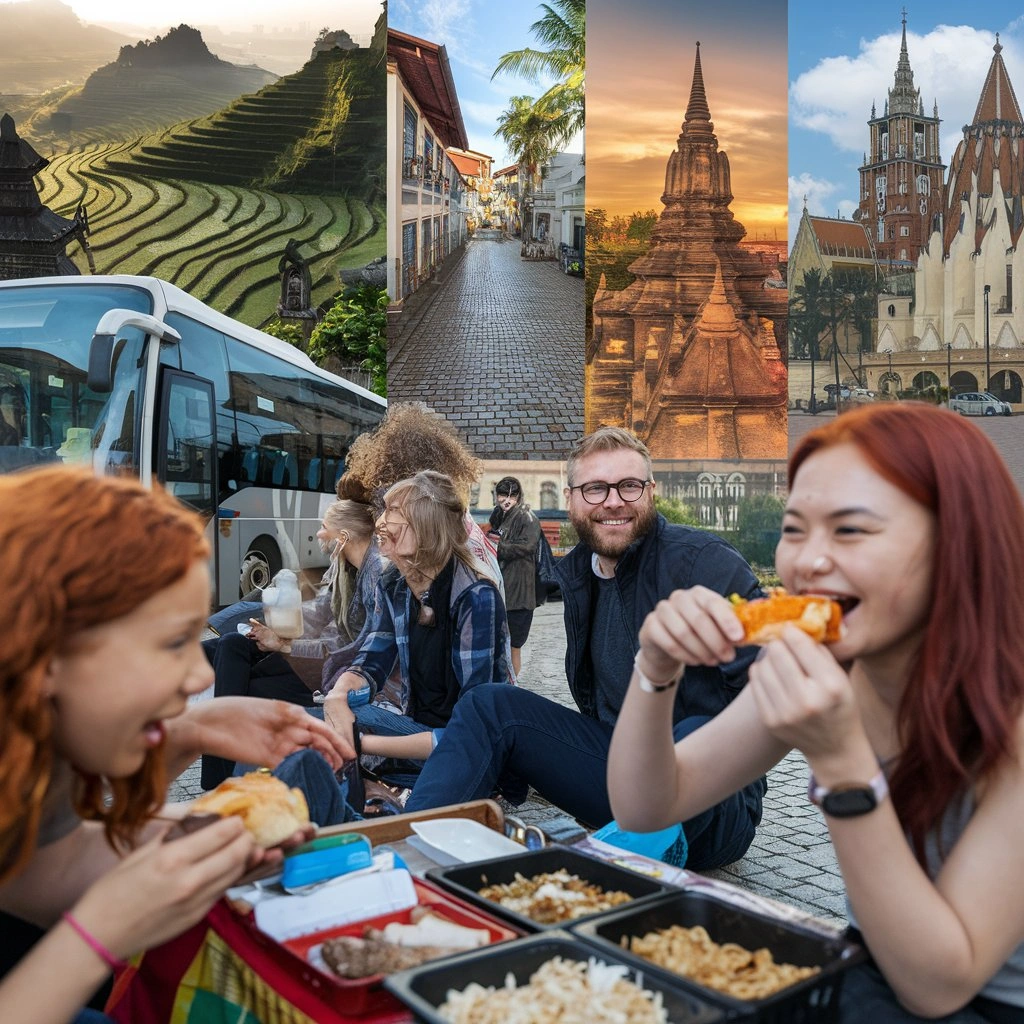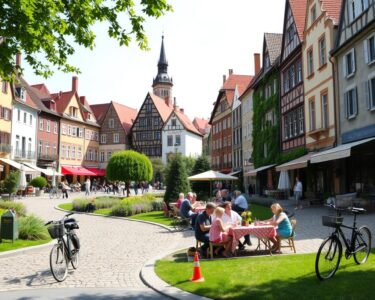Table of Contents
Unveiling the Culinary Delights: 10 Must-Visit Destinations for Foodies
For food enthusiasts, traveling becomes a delicious journey of discovery. If you’re a foodie eager to explore unique flavors, diverse cultures, and mouth-watering dishes, you’re in for a treat. Here are ten must-visit destinations that guarantee unforgettable culinary experiences.
1. Tokyo, Japan
Tokyo is a paradise for food lovers. From sushi to ramen, the city offers an endless array of culinary delights. Try fresh sushi at the historic Tsukiji Outer Market or indulge in flavorful ramen at one of the myriad ramen shops scattered throughout the city. Don’t forget to explore Izakayas, traditional Japanese gastropubs, for a taste of local drinks and small plates.
2. Paris, France
The City of Light is synonymous with gourmet cuisine. Delight in flaky croissants, fine cheeses, and rich pastries at charming street-side cafés. Make a reservation at a Michelin-starred restaurant for an unforgettable fine dining experience. Be sure to explore the local bistros and patisseries to savor authentic French flavors.
3. Bangkok, Thailand
Bangkok’s street food scene is legendary. The bustling markets and street stalls offer a medley of dishes bursting with flavor. Enjoy pad thai, green curry, and mango sticky rice while wandering the vibrant streets. A food tour can be a great way to discover hidden gems and experience the culture of this flavorful city.
4. Barcelona, Spain
Barcelona is famous for its tapas culture. Head to La Boqueria market for an explosion of fresh produce, cured meats, and seafood. Sample small plates of patatas bravas, jamón ibérico, and paella at local bars. The fusion of modern culinary techniques with traditional flavors makes Barcelona a true culinary hotspot.
5. Mexico City, Mexico
The culinary scene in Mexico City is rich and diverse. Savor authentic tacos al pastor from a street vendor, explore local markets, and try mole, a sauce rich with flavor. Visit high-end restaurants for innovative takes on traditional dishes, or take a cooking class to immerse yourself in Mexican culinary arts.
6. Istanbul, Turkey
Istanbul is a vibrant mix of flavors and traditions. The city is renowned for its kebabs, baklava, and Turkish delights. Food lovers can take a cruise on the Bosphorus while enjoying a meal or join a culinary walking tour to explore the bustling markets and try local street food.
7. New Orleans, USA
For a unique blend of cultures, New Orleans offers a culinary experience like no other. Savor gumbo, jambalaya, and beignets while enjoying the lively atmosphere of this vibrant city. Explore the French Quarter, where restaurants serve classic Creole dishes that highlight the region’s rich culinary heritage.
8. Bangkok, Thailand
Bangkok’s street food scene is unparalleled. Vendors line the streets offering everything from spicy papaya salad to grilled satay. Don’t miss out on trying the traditional Thai dessert, mango sticky rice. A guided food tour can expose you to hidden culinary delights while providing insights into the local culture.
9. Melbourne, Australia
Melbourne is a melting pot of flavors, with a dynamic food scene influenced by various cultures. Visit the iconic Queen Victoria Market to sample local cheeses, meats, and gourmet produce. Try Australian classics like meat pies or venture into the city’s lively café culture for exceptional coffee and brunch options.
10. Florence, Italy
Florence is the heart of Tuscan cuisine. Enjoy traditional dishes like ribollita and pappa al pomodoro in quaint trattorias. The Mercato Centrale offers fresh produce, cheeses, and local wines, perfect for tasting authentic Italian flavors. Cooking classes are a great way to learn more about the culinary heritage of this beautiful city.
These ten destinations are sure to satisfy your culinary cravings. Each city offers a unique blend of food experiences that will not only tantalize your taste buds but also create lasting food memories. Whether you’re indulging in street food or dining in upscale restaurants, these foodie havens will inspire and delight every taste.
Explore : 7 Tips for Planning the Perfect Vacation Without Overspending

An Exploration of Global Street Food: Why It’s a Foodie’s Paradise
If you’re a food lover, the world has a treasure trove of delights waiting for you. Street food, in particular, offers a unique glimpse into local cultures and culinary traditions. From tantalizing flavors to vibrant colors, street food is truly a foodie’s paradise. Here’s why you should explore global street food, along with some must-try experiences around the world.
The Allure of Street Food
Street food is more than just quick bites; it’s about experience, connection, and discovery. When you eat where locals eat, you experience authentic flavors and cooking methods that have been passed down through generations. Here are a few compelling reasons to dive into street food:
- Affordability: Street food is often much cheaper than dining in restaurants, allowing you to try various dishes without breaking the bank.
- Accessibility: Street vendors are everywhere, making it easy to grab a bite on the go while exploring new places.
- Unique Flavors: Each region boasts its specialties, offering blends of spices and ingredients that you won’t find anywhere else.
- Local Culture: Eating street food allows you to immerse yourself in the local community, seeing how people live and enjoy their meals.
- Fresh Ingredients: Many street foods are prepared on the spot using fresh, local ingredients, which enhances the flavor and quality of the dish.
Must-Try Street Foods from Around the World
Now, let’s embark on a culinary journey and discover some of the best street food destinations across the globe:
1. Bangkok, Thailand
The bustling streets of Bangkok are filled with food stalls serving dishes like Pad Thai and Som Tam. Don’t miss out on grabbing a skewered Satay or a bowl of Tom Yum soup—each bite bursting with unique flavors.
2. Mexico City, Mexico
In Mexico City, street food is a way of life. Try Tacos al Pastor filled with marinated pork, topped with onion and cilantro. Other must-tries include Elotes (corn on the cob) slathered in cheese and chili.
3. Istanbul, Turkey
Istanbul’s street food scene is diverse and delicious. Don’t leave without tasting Simit (sesame-crusted bread) or Kebabs from the many vendors scattered around the city. Pair these with a cup of tea for an authentic experience.
4. Tokyo, Japan
Tokyo’s street food offers a taste of culinary creativity. Sample Takoyaki (octopus balls) or Yakisoba (fried noodles) served hot from kiosks. Make sure to visit during festivals to enjoy grilled Yakitori skewers.
5. Mumbai, India
Mumbai is famous for its street food stalls, where you can savor varieties like Pav Bhaji and Bhel Puri. These dishes are bursting with spices and fresh ingredients that reflect the local culture.
How to Enjoy Street Food Safely
While street food is often safe and delicious, taking some safety precautions can enhance your experience:
- Choose busy locations where locals are eating; this usually indicates freshness.
- Watch how food is prepared and ensure that hygiene standards are met.
- Start with cooked food, which is generally safer than raw items.
- Don’t be afraid to ask vendors about the ingredients and how the food is prepared.
The Joy of Discovery
Exploring global street food not only tantalizes the taste buds but also enriches the travel experience. As you savor each bite, you’ll find that food has the power to connect people across cultures. So grab a plate, dive in, and let your senses guide you through a journey of flavors that will surely leave you craving more. Whether you’re wandering the vibrant streets of Bangkok or bustling markets of Mexico City, food is an adventure waiting to happen.
With these experiences in mind, you’re ready to step out and explore! Enjoy your culinary journey through the world of street food—where every corner has a new flavor to discover.

The Role of Local Ingredients in Defining Regional Cuisine
When it comes to defining regional cuisine, the spotlight often shines on local ingredients. These ingredients are more than just food items; they are the essence of a community’s culture, traditions, and culinary identity. From the rich flavors of fresh herbs to the hearty grains cultivated in nearby fields, local ingredients shape the dishes that define an area. By exploring the role of local ingredients, we can better appreciate the unique tastes found in different regions around the globe.
One of the most compelling reasons local ingredients play such a vital role in regional cuisine is the connection they foster between the food and the land. The climate, soil, and geography of a particular area dictate what crops can be grown and what animals can be raised. This inherent relationship leads to a natural and organic cuisine that reflects the local environment. For example, Mediterranean regions thrive on olive oil, fresh tomatoes, and seafood, all of which are abundantly available due to the climate and coastal geography.
Additionally, local ingredients contribute to seasonal eating, which is gaining popularity among food enthusiasts. When dishes are prepared using ingredients that are in season, the flavors become fresher and more vibrant. This means that the cuisine can change throughout the year, providing a delightful variety for the palate. You might find a hearty squash soup in the fall, a refreshing summer salad filled with tomatoes in July, or warm, rich stews in winter. This dynamic aspect of cooking encourages you to engage with food in a more meaningful way.
Local ingredients also play a crucial role in sustainability. When chefs and homecooks prioritize sourcing food from nearby farms, they reduce the carbon footprint associated with transportation and support local economies. You can often taste the difference when you opt for ingredients that haven’t traveled thousands of miles. Farm-to-table practices have become increasingly popular, allowing diners to connect directly with producers, enhancing the relationship not only with the food but also with the community.
Regional cuisine often tells stories through its local ingredients. Each ingredient has its own history and significance, which weaves a narrative of the people and the place. Consider the use of spices in Indian cuisine. The spices that characterize this food are not just flavoring agents; they are a reflection of the region’s trade history and agricultural practices. Each spice used in traditional dishes speaks to a heritage that has been cultivated over generations, offering a unique glimpse into the culture.
The impact of local ingredients on beverages cannot be overlooked either. Think about the wines produced in specific regions, such as Napa Valley or Bordeaux. The unique characteristics of the grapes grown there yield distinct flavors. Similarly, craft breweries often use local grains and hops, resulting in craft beers that celebrate their location. When you sip on a locally made beverage, you are, in essence, tasting the region itself.
Several regions stand out for their distinctive flavors based largely on local ingredients. Here are a few noteworthy examples:
- Tuscany, Italy: Known for its rich olive oil, robust wines, and fresh produce like tomatoes and artichokes, Tuscan cuisine celebrates simplicity and quality.
- Chennai, India: Renowned for its use of rice, coconut, and myriad spices, local ingredients define the unique flavors of South Indian cuisine.
- Tokyo, Japan: Sushi often highlights local seafood and seasonal vegetables, emphasizing fresh and minimalistic flavor profiles.
- Mexico City, Mexico: Corn, beans, and chilies play vital roles in traditional dishes, showcasing the country’s agricultural diversity.
- Provence, France: Famous for herbs like thyme and rosemary, this region’s cuisine is marked by its vibrant colors and strong flavors derived from local produce.
Ultimately, the role of local ingredients in defining regional cuisine goes beyond mere taste. It encompasses culture, sustainability, and a connection to the earth. When you embrace dishes made from local ingredients, you not only enjoy the unique flavors but also support local farmers and communities. So the next time you sit down for a meal, take a moment to consider the journey of those ingredients from farm to table. The local flavors you savor are not just food on your plate; they are a reflection of a rich tapestry woven through history, culture, and the land itself.
Unique Dining Experiences: Beyond Traditional Restaurants
When it comes to dining, traditional restaurants are just the tip of the iceberg. There’s a whole world of unique dining experiences that can elevate your meal into a memorable adventure. Whether you’re a foodie seeking the extraordinary or simply looking for a fun night out, here are some amazing options you should consider.
1. Dinner in the Sky
Imagine enjoying an exquisite meal while suspended 150 feet in the air! Dinner in the Sky serves as a platform where you can enjoy a multi-course meal with stunning views. Chefs prepare gourmet dishes right at your table while you savor the thrill of dining high above the ground.
2. Themed Restaurants
Themed restaurants take dining to another level by transporting you to another world. From medieval banquets to a transformer-inspired dining experience, these restaurants provide immersive environments. Dine among pirates, space astronauts, or even in a location inspired by your favorite movie. The creativity extends to the menu, offering unique, themed dishes that enhance the overall experience.
3. Cooking Classes
What if you could combine learning and dining? Cooking classes let you create your own meal with guidance from expert chefs. Enjoy hands-on experience, learn new techniques, and take home recipes to impress your friends. Plus, there’s nothing quite like enjoying a meal you cooked yourself! Some classes even offer wine pairing, enhancing the experience further.
4. Pop-Up Restaurants
Pop-up restaurants are a trendy way to experience unique flavors in a temporary setting. They often feature seasonal menus crafted by renowned chefs who want to experiment with new dishes. Since these spots are open for a limited time, they create excitement in the dining community. Be sure to keep track of upcoming pop-ups to indulge in extraordinary culinary creations.
5. Floating Restaurants
Floating restaurants offer a unique twist on waterfront dining. Whether you’re on a boat or a barge, being out on the water adds a special element to your meal. Enjoy fresh seafood with waves lapping at your sides, or feast on local cuisine while canoeing down a serene river. The ever-changing scenery enhances the flavors on your plate.
6. Dinner Theaters
For fans of performing arts, dinner theaters combine great meals with live entertainment. As you dine, enjoy a show that might feature anything from comedy to musicals. This immersive experience engages your senses, offering both visual and culinary delights, making it an ideal choice for a special night out.
7. Underground Suppers
Underground supper clubs often involve secret locations where exclusive dining experiences unfold. These intimate gatherings allow you to socialize with fellow foodies and savor chef-curated menus in a unique setting. Each supper is different and often features local ingredients prepared with artistry and flair.
8. Edible Art Installations
Edible art installations combine creativity and culinary skills, giving you the chance to eat what you admire. These events turn food into a canvas, showcasing intricate designs that challenge the notion of dining. You might find everything from chocolate sculptures to vegetable creations that are as beautiful as they are delicious.
9. Foraging Experiences
Foraging experiences change how you view food. Accompany an expert forager into the wild to gather seasonal ingredients. After a day of collecting, you return to a kitchen for a cooking session using what you’ve gathered. This adventure not only connects you with nature but also deepens your appreciation for fresh, organic ingredients.
10. Dining With a View
You can choose to dine with stunning views that enhance your culinary experience. Restaurants located in skyscrapers, mountain tops, or alongside the ocean often offer breathtaking scenery along with their dishes. Enjoying a meal while gazing at a sunset or city skyline creates a lasting memory.
In a world where culinary creativity knows no bounds, unique dining experiences can transform an ordinary meal into an extraordinary adventure. Whether it’s soaring high above the city, participating in a cooking class, or dining by the water, these options cater to all tastes and interests. The next time you’re looking for something beyond the norm, explore one of these captivating dining experiences and indulge in the art of eating!

Culinary Tours: How to Enhance Your Travel Experience Through Food
Exploring different cultures is one of the joys of travel, and engaging with local food is a wonderful way to dive deep into any destination. Culinary tours, designed specifically to showcase regional cuisine, allow you to embark on a flavorful encounter that enhances your overall travel experience. Here’s how you can supercharge your adventures through food.
Discover Authentic Flavors
One of the best aspects of culinary tours is that they often take you off the beaten path. You can explore local markets, street food stalls, and hidden restaurants that you might not find on your own. This is where you encounter authentic flavors and ingredients you won’t find in touristy spots.
Explore Local Ingredients
- Farmers’ Markets: Visit farmers’ markets to see firsthand where locals source their ingredients.
- Cooking Classes: Take part in cooking classes that include visits to local suppliers and shops.
- Production Tours: Consider a tour of local producers, such as cheese makers or wineries.
Eating local isn’t just tastier; it also gives insight into the agriculture and climate of the region, enriching your understanding of the culture.
Enhance Cultural Understanding
Food is closely tied to culture, and participating in culinary tours provides a window into local traditions. You’ll likely learn about the history behind various dishes, from cultural influences to family recipes passed through generations. Engaging with local chefs and home cooks can deepen your appreciation for the art of cooking.
Participate in Traditional Events
- Festivals: Join food festivals where you can taste a variety of local dishes.
- Home Dinners: Experience a meal with a local family to savor traditional recipes made from scratch.
- Culinary Workshops: Participate in workshops that focus on specific cuisines and cooking techniques.
These experiences not only fill your belly; they also fill your mind with stories and traditions that you can carry with you long after the trip is over.
Meet Like-Minded Food Lovers
Culinary tours are fantastic ways to meet fellow food enthusiasts. Whether you’re joining a group tour or participating in smaller classes, you’ll likely bond with others over shared tastes and experiences. This is a great opportunity to expand your social circle.
Network and Share Experiences
- Food Blogs: Connect with fellow travelers and locals to swap recipes and tips.
- Social Media: Share your food experiences online, attract more friends with similar interests.
- Food Groups: Join food-related groups to stay in touch and plan future adventures together.
Sharing these experiences can lead to friendships that last beyond the journey, often leading to future travel plans together.
Learn New Skills
Taking part in culinary tours often allows you to acquire new cooking skills. Many programs include hands-on activities that teach you everything from basic knife skills to advanced cooking techniques. By the end, you’ll not only have tasty recipes to replicate at home but also the confidence to try new dishes.
Skills You Might Learn
- Knife Skills: Learn how to chop vegetables quickly and efficiently.
- Flavor Balancing: Gain insights into balancing flavors in a dish.
- Presentation: Discover techniques for presenting your meals beautifully.
These new skills can enrich your home cooking and entertaining, allowing you to impress friends and family with dishes inspired by your travels.
Travel Through Tastes
Culinary tours emphasize the idea that food is the gateway to experience a culture fully. Each dish tells a story, one that has often been shaped by geography, climate, and history. The nuances of regional flavors add layers to your journey, making each meal an adventure.
As you plan your next trip, consider weaving in culinary tours to create a richer experience. From exploring local markets and mastering cooking classes to meeting fellow foodies and learning new skills, you’ll find that indulging in local cuisine can transform ordinary travel into extraordinary memories.
These tours offer unforgettable insights and connections, transforming travel into a feast for the senses.
Conclusion
As you embark on your journey through these 10 must-visit destinations for foodies, remember that each location offers a unique tapestry of flavors, aromas, and culinary traditions. Exploring global street food immerses you in local culture while providing delicious, authentic bites that often tell a story of their own. These tantalizing treats showcase the ingenuity of street vendors and their dedication to using local ingredients, which not only enhance the taste but also connect you to the region’s agricultural heritage.
The beauty of dining experiences in these destinations extends beyond traditional restaurants. Engaging in unique settings, from rooftop gardens to rustic farmhouses, can elevate your meals and create lasting memories. Don’t forget that culinary tours are an invaluable way to dive deeper into the food scene. They enrich your travel experience by offering insights into food preparation, ingredient sourcing, and the history behind the dishes you enjoy.
By embracing the local cuisine, you become a part of the community, celebrating traditions and flavors that have been passed down through generations. Each meal becomes not just sustenance but an adventure—an opportunity to connect with the spirit of each place. As you set off on your foodie travels, let your palate lead the way. Open yourself to new experiences and remember that food is more than just what’s on the plate; it’s about the stories, connections, and memories formed around it. Enjoy the journey and savor every bite!






